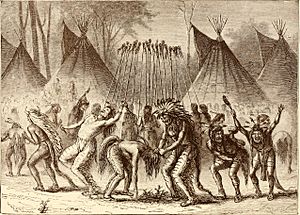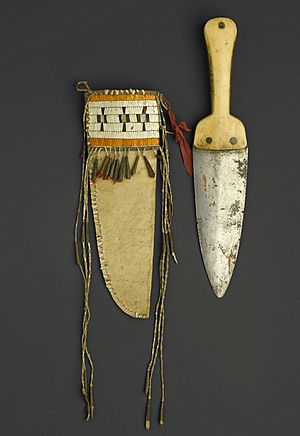Scalping facts for kids
Scalping is the act of cutting or tearing a part of the human scalp, with hair attached, from the head, and generally occurred in warfare with the scalp being a trophy. Scalp-taking is considered part of the broader cultural practice of the taking and display of human body parts as trophies. Scalping independently developed in various cultures in both the Old and New Worlds.
Scalping was not in itself fatal, though it was most commonly inflicted on the gravely wounded or the dead.
In different cultures
Europe
Several human remains from the stone-age Ertebølle culture in Denmark show evidence of scalping.
The Abbé Emmanuel H. D. Domenech referred to the decalvare of the ancient Germans and the capillos et cutem detrahere of the code of the Visigoths as examples of scalping in early medieval Europe, though some more recent interpretations of these terms relate them to shaving off the hair of the head as a legal punishment rather than scalping.
In England in 1036, Earl Godwin, father of Harold Godwinson, was reportedly responsible for scalping his enemies, among whom was Alfred Aetheling.
Asia
There is physical evidence that scalping was practiced during the Longshan and Erlitou periods in China's central plain.
A skull from an Iron Age cemetery in South Siberia shows evidence of scalping.
Some evidence is also found in the Indian Subcontinent.
Americas
There is substantial archaeological evidence of scalping in North America in the pre-Columbian era. Carbon dating of skulls show evidence of scalping as early as 600 AD; some skulls show evidence of healing from scalping injuries, suggesting at least some victims occasionally survived at least several months. Among Plains Indians, it seems to have been practiced primarily as part of intertribal warfare, with scalps only taken of enemies killed in battle.
Many tribes of Native Americans practiced scalping, in some instances up until the end of the 19th century. European colonisation of the Americas increased the incidence of intertribal conflict, and consequently an increase in the prevalence of scalping.
Techniques
Specific scalping techniques varied somewhat from place to place, depending on the cultural patterns, but the general process of scalping was quite uniform. The scalp was separated from the skull along the plane of the areolar connective tissue with a sharp instrument. The earliest instruments used in scalping were stone knives crafted of flint, chert, or obsidian, or other materials like reeds or oyster shells that could be worked to carry an edge equal to the task. Collectively, such tools were also used for a variety of everyday tasks like skinning and processing game, but were replaced by metal knives acquired in trade through European contact.
Image gallery
-
Survivor Robert McGee was scalped as a child in 1864 by Sioux —photo c. 1890.
-
Native American Big Mouth Spring with decorated scalp lock on right shoulder. 1910 photograph by Edward S. Curtis
-
Modern roadside historical marker in Boscawen, New Hampshire about the 1697 scalping incident involving Hannah Duston
See also
 In Spanish: Escalpelamiento para niños
In Spanish: Escalpelamiento para niños







